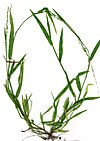Arundinarieae
Appearance
| Arundinariae | |
|---|---|

| |
| Arundinaria pumila | |
| Scientific classification | |
| Kingdom: | |
| (unranked): | |
| (unranked): | |
| (unranked): | |
| Order: | |
| Family: | |
| Subfamily: | |
| Supertribe: | Arundinarodae L.Liu (1980)
|
| Tribe: | Arundinarieae |
| Subtribe: | Arundinariineae |
| Genera | |
|
30 genera, see text | |
| Synonyms[1] | |
| |
Arundinarieae is a tribe of bamboo in the grass family (Poaceae), placed in its own supertribe Arundinarodae and containing a single subtribe, Arundinariinae, and 30 genera.[1] These woody bamboos occur in areas with warm temperate climates in southeastern North America, Subsaharan Africa, South Asia and East Asia. The tribe forms a lineage independent of the tropical woody bamboos (Bambuseae) and the tropical herbaceous bamboos (Olyreae).[2]
Genera
- Acidosasa
- Ampelocalamus
- Arundinaria
- Bashania
- Bergbambos
- Chimonobambusa
- Chimonocalamus
- Drepanostachyum
- Fargesia
- Ferrocalamus
- Gaoligongshania
- Gelidocalamus
- Himalayacalamus
- Indocalamus
- Indosasa
- Kuruna
- Oldeania
- Oligostachyum
- Phyllostachys
- Pleioblastus
- Sarocalamus
- Pseudosasa
- Sasa
- Sasaella
- Sasamorpha
- Semiarundinaria
- Shibataea
- Sinobambusa
- Thamnocalamus
- Vietnamocalamus
- Yushania
See also
References
- ^ a b Soreng, Robert J.; Peterson, Paul M.; Romaschenko, Konstantin; Davidse, Gerrit; Zuloaga, Fernando O.; Judziewicz, Emmet J.; Filgueiras, Tarciso S.; Davis, Jerrold I.; Morrone, Osvaldo (2015). "A worldwide phylogenetic classification of the Poaceae (Gramineae)". Journal of Systematics and Evolution. 53 (2): 117–137. doi:10.1111/jse.12150. ISSN 1674-4918.

- ^ Kelchner S, Bamboo Phylogeny Working Group (2013). "Higher level phylogenetic relationships within the bamboos (Poaceae: Bambusoideae) based on five plastid markers" (PDF). Molecular Phylogenetics and Evolution. 67 (2): 404–413. doi:10.1016/j.ympev.2013.02.005. ISSN 1055-7903.

